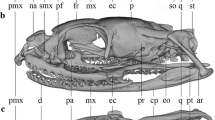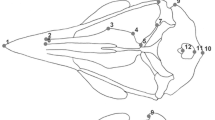Abstract
Morphological diversity of 47 pygoscelid skulls was tested empirically through geometric morphometrics approach. Using 14 landmarks, shape is analyzed independently of other aspects of the body form. The shape disparity within and between the three living species of Pygoscelis is explored as well as how the structure of the skull is related to food preferences. Comparison of the three mean configurations of the species suggests that differences among groups are small relative to the variability within each group. However, some differences at the posterior portion of the braincase are indicated. Sexual dimorphism within each species is not noticeable. Comparison with a piscivorous species (Spheniscus humboldti) shows two cranial patterns: pygoscelid type with wide nasal gland depression limited by well-marked edges, shallow temporal fossae, and a poorly developed temporal nuchal crest; the second type represented by Spheniscus humboldti with laterally open nasal gland depression, deep temporal fossae, and a well-developed temporal nuchal crest.





Similar content being viewed by others
References
Barbosa A, Moreno E (1999) Hindlimb morphology and locomotor performance in waders. An evolutionary approach. Biol J Linn Soc 67:313–330
Bertelli S, Giannini N (2005) A phylogeny of extant penguins (Aves: Sphenisciformes) combining morphology and mitochondrial sequences. Cladistics 21:209–239
Bookstein FL (1996) Biometrics, biomathematics and the morphometric synthesis. Bull Math Biol 58:313–365
Bost CA, Georges JY, Guinet C, Cherel Y, Puetz K, Charrassin JB, Handrich Y, Zorn T, Lage J, Le Maho Y (1997) Foraging habitat and food intake of satellite-tracked king penguins during the austral summer at Crozet Archipelago. Mar Ecol Prog Ser 150:21–33
Clausen AP, Arkhipkin AI, Laptikhovsky VV, Huin N (2005) What is out there: diversity in feeding of gentoo penguins (Pygoscelis papua) around the Falkland Island (South West Atlantic). Polar Biol 8:653–662
Eason D, Millar CD, Cree A, Halverson J, Lambert DM (2001) The Takahe (Porphyrio mantelli): a comparison of five methods for avian sex assignment. J Zool 253:281–292
Giannini NP, Bertelli S (2004) Phylogeny of extant penguins based on integumentary and breeding characters. Auk 121:421–434
Griffin TM, Kram R (2000) Penguin wadding not wasteful. Nature 408:929
Knowies K, Agnew D, Clarke J, Else G (1992) Use of morphometric parameters for the determination of sex of Adelie penguins. Wildl Res 19:657–664
Kooyman GL, Cherel Y, Le Maho Y, Croxall JP, Thorson PH, Ridoux V, Kooyman CA (1992) Diving behavior and energetics during foraging cycles in king penguins. Ecol Monogr 62:143–163
Martínez I (1992) Order Sphenisciformes. In: del Hoyo J, Elliott y A, Sargatal J (eds) Handbook of the birds of the world, vol 1. Ostrich to Ducks. Links ediciones, Barcelona, pp 140–160
Pinshow B, Fedack MA, Schmidt-Nielsen K (1976) Terrestrial locomotion in penguins: it costs more to waddle. Science 195:592–594
Pycraft WP (1898) Contributions to the osteology of birds, part II. Impennes. Proc Zool Soc Lond: 958–989
Rabello Monteiro L, Furtado dos Reis S (1999) Princípios de morfometria geométrica. Holos editora, Ribeiro Preto, 198 pp
Rohlf FJ (2005) tpsDig, digitize landmarks and outlines, version 2.04. Department of Ecology and Evolution, State University of New York at Stony Brook
Rohlf FJ, Slice DE (1990) Extensions of the Procrustes method for the optimal superimposition of landmarks. Syst Zool 39:40–59
Scolaro JA (1987) Sexing fledglings and yearlings of Magellanic penguins by discriminant analysis of morphometric parameters. Colonial Waterbirds 10:50–54
Setiawan AN, Darby JT, David L (2004) The use of morphometric measurements to sex yellow-eyed penguins. Waterbirds 27:96–101
Slice DE (1994–1998) Morpheus et al.: software for morphometric research. Revision 01-30-98. Department of Ecology and Evolution, State University of New York at Stony Brook
Small CG (1996) The statistical theory of shape. Springer, Berlin Heidelberg New York, 227 pp
Williams TD (1995) The penguins. Spheniscidae. Birds families of the world. Oxford University Press, Oxford, 295 pp
Woehler EJ (1993) The distribution and abundance of Antarctic and subantarctic penguins. Scientific Committee on Antarctic Research. University of Cambridge, 76 pp
Zusi RL (1975) An interpretation of skull structure in penguins. In: Stonehouse B (ed) The biology of penguins. Macmillan Press, London, pp 59–84
Zusi RL (1993) Patterns of diversity in the avian skull. In: Hanken J, Hall B (eds) The skull. vol 2. Patterns of structural and systematic diversity. University of Chicago Press, Chicago, pp 391–437
Acknowledgements
The authors wish to thank Paula González for valuable help concerning to data processing; to Diego Montalti for access to materials of Instituto Antártico Argentino and his useful data, to Esteban Soibelzon and Martín Ciancio for information on pygoscelid habits. To an anonymous reviewer and specially, to Stig Walsh for improving our English and his useful comments.
Author information
Authors and Affiliations
Corresponding author
Appendix: materials used in the morphometric analyses performed
Appendix: materials used in the morphometric analyses performed
P. adeliae: MLP 32, MLP 33, MLP 415, MLP 416, MLP 417, MLP 418, MLP 419, MLP 420, MLP 421, MLP 422, MLP 423, MLP 424, MLP 425, MLP 426, MLP 427, MLP 428, MLP 429, MLP 430, MLP 431, MLP 432, MLP 433, MLP 434. Pygoscelis antarctica: IAA 54, IAA 65, IAA 76, IAA 157, IAA 158, MLP 435, MLP 436, MLP 437, MLP 438, MLP 439, MLP 440, MLP 441, MLP 442, MLP 443, MLP 444, MLP 447. Pygoscelis papua: IAA 24, IAA 81, IAA 82, IAA 88, IAA 160, MLP 449, MLP 451, MLP 463, MLP 468. Spheniscus humboldti: MLP 686.
Rights and permissions
About this article
Cite this article
Acosta Hospitaleche, C., Tambussi, C. Skull morphometry of Pygoscelis (Sphenisciformes): inter and intraspecific variations. Polar Biol 29, 728–734 (2006). https://doi.org/10.1007/s00300-006-0109-6
Received:
Revised:
Accepted:
Published:
Issue Date:
DOI: https://doi.org/10.1007/s00300-006-0109-6




